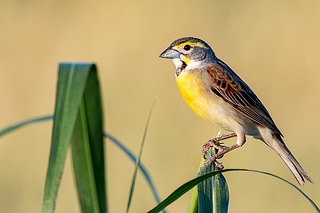
Cardinalidae is a family of New World-endemic passerine birds that consists of cardinals, grosbeaks, and buntings. It also includes several birds such as the tanager-like Piranga and the warbler-like Granatellus. As such, membership of this group is not easily defined by a single or even a set of physical characteristics, but instead by molecular work. In general they are medium to large songbirds with stout features, some with large heavy bills.
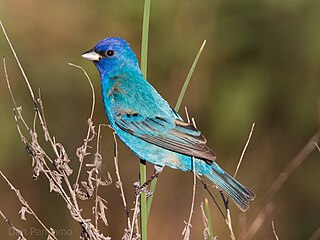
The indigo bunting is a small seed-eating bird in the cardinal family, Cardinalidae. It is migratory, ranging from southern Canada to northern Florida during the breeding season, and from southern Florida to northern South America during the winter. It often migrates by night, using the stars to navigate. Its habitat is farmland, brush areas, and open woodland. The indigo bunting is closely related to the lazuli bunting and interbreeds with the species where their ranges overlap.

Legge's flowerpecker or the white-throated flowerpecker, is a small passerine bird. It is an endemic resident breeder in Sri Lanka. It is named after the Australian ornithologist William Vincent Legge.

The lazuli bunting is a North American songbird named for the gemstone lapis lazuli.
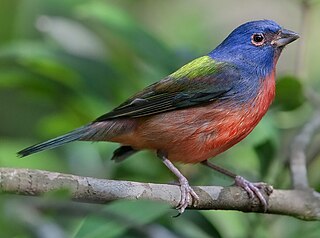
The painted bunting is a species of bird in the cardinal family, Cardinalidae. It is native to North America. The bright plumage of the male only comes in the second year of life; in the first year they can only be distinguished from the female by close inspection.

The varied bunting is a species of songbird in the cardinal family, Cardinalidae.

The blue grosbeak, is a medium-sized North American passerine bird in the cardinal family Cardinalidae. It is mainly migratory, wintering in Central America and breeding in northern Mexico and the southern United States. The male is blue with two brown wing bars. The female is mainly brown with scattered blue feathers on the upperparts and two brown wing bars.
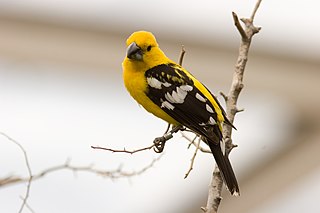
The yellow grosbeak, also known as the Mexican yellow grosbeak, is a medium-sized seed-eating bird in the same family as the northern cardinal, "tropical" or "New World" buntings, and "cardinal-grosbeaks" or New World grosbeaks.

The stripe-headed sparrow is an American sparrow which breeds from Pacific coastal south-western Mexico, including the transverse ranges, Cordillera Neovolcanica to Pacific coastal northern Costa Rica.

The buff-bellied hummingbird is a species of hummingbird in the "emeralds", tribe Trochilini of subfamily Trochilinae. It is found in Belize, Guatemala, Mexico, and the United States.
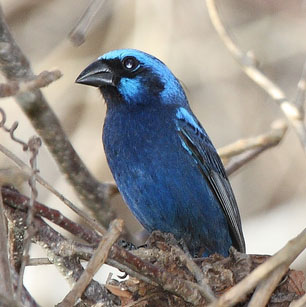
The blue bunting is a species of passerine in the family Cardinalidae, the cardinals or cardinal grosbeaks. It is found in Belize, El Salvador, Guatemala, Honduras, Mexico, and Nicaragua.

The golden-breasted bunting is a passerine bird in the bunting family Emberizidae. It occurs in dry open woodlands and moist savanna in Africa south of the Sahara, but is absent from the equatorial forest belt.
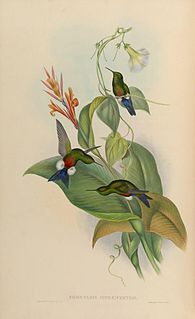
The coppery-bellied puffleg is a species of hummingbird in the "brilliants", tribe Heliantheini in subfamily Lesbiinae. It is found in Colombia and Venezuela.

The violet-throated metaltail, locally called metalura gorjivioleta, is an Endangered species of hummingbird in the "coquettes", tribe Lesbiini of subfamily Lesbiinae. It is endemic to Ecuador.

The white-bellied chachalaca is a species of bird in the family Cracidae, the chachalacas, guans, and curassows. It is found in El Salvador, Guatemala, Honduras, Mexico, and Nicaragua.
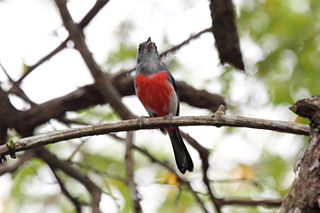
The grey-throated chat is a species of bird in the family Cardinalidae, the cardinals or cardinal grosbeaks. It is found in Belize, Guatemala, and Mexico.

The red-breasted chat is a species of bird in the family Cardinalidae, the cardinals or cardinal grosbeaks. It is endemic to Mexico.

The lemon-bellied flyrobin or lemon-bellied flycatcher is a species of bird in the family Petroicidae. Found in Australia, Indonesia, and Papua New Guinea, its natural habitats are subtropical or tropical moist lowland forests and subtropical or tropical mangrove forests.

The orange-breasted bunting is a species of passerine bird in the family Cardinalidae. It is endemic to Mexico, where its natural habitats are subtropical or tropical dry forests and subtropical or tropical dry shrubland. With its wide range and large total population, the International Union for Conservation of Nature considers it as being of "least concern".

The flame-faced tanager is a species of bird in the tanager family Thraupidae. It is endemic to South America and is found in the eastern Andes of Colombia, Ecuador, Peru and Venezuela. Its natural habitat is subtropical or tropical moist montane forests. It is a distinctive-looking species with black and opalescent green upperparts, opalescent green and buff underparts, and a deep red and yellow face. The subspecies lunigera lacks the deep red on the face, which is replaced with orangish-red.






















